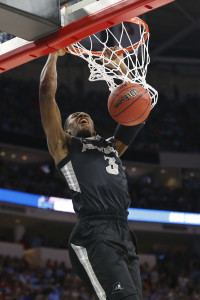OVERVIEW: Kris Dunn put Providence back on the national map over the past two seasons by emerging as one of the nation’s top point guards. His college career got off to a slow start, as he endured two shoulder surgeries in a span of 18 months. Once he was finally healthy during his redshirt sophomore season, he quickly established himself as a premier floor leader. He averaged 15.6 points, 5.5 rebounds and a 7.5 assists in his breakout year and followed that up with a 16.4/5.3/6.2 slash line in his junior year. The 6’4” Dunn finished his college career with a 29-point outburst against North Carolina in the second round of the NCAA Tournament.
STRENGTHS: In a league that increasingly values quickness and ability to get to the rim, Dunn seems like a prototypical point guard. He should be an outstanding pick-and-roll initiator with his ability to blow past defenders as well as hit outside shots and create opportunities for himself and others. He should have a size and strength advantage over many of his peers that will make him difficult to guard in one-on-one matchups. As Jonathan Givony of DraftExpress points out, he has the ability to operate at different speeds, making him dangerous in half-court sets as well as in transition. He doesn’t shoot a lot of 3-pointers, but he makes an acceptable percentage, hitting at a 37.2% clip. Dunn can also be a major factor defensively. He has excellent length with a 6’8” wingspan and uses it to his advantage. The two-time Big East Player of the Year led the conference in steals each of the past two seasons. His quickness allows him to stay in front of his man, while his size gives him the ability to seamlessly switch defensive assignments between point and shooting guards.
WEAKNESSES: The two biggest knocks on Dunn, according to ESPN Insider Chad Ford, are his tendency to take questionable shots and his turnover rate. Dunn’s field-goal percentage fell from 47.4% as a sophomore to 44.8% this season, despite his improvement from long range. Givony notes that Dunn shows average touch around the rim when forced to finish over length and tends to avoid contact at all costs, perhaps because of his prior shoulder problems. That could become an even bigger issue at the NBA level, where he’ll encounter better closeouts and shot blockers. Dunn can also get careless with the ball. He improved somewhat over the past year, bringing his turnovers down from a whopping 4.2 per game to 3.5. That’s still a high number, as only three NBA point guards are currently averaging more than 3.5 per game and that same trio — Rajon Rondo, John Wall and Russell Westbrook — are also the only players averaging double-digit assists. As Givony describes it, Dunn can make some eye-catching moves with the ball, but he can also get very sloppy with his handle.
(For Part Two of Kris Dunn’s prospect profile, click here.)
